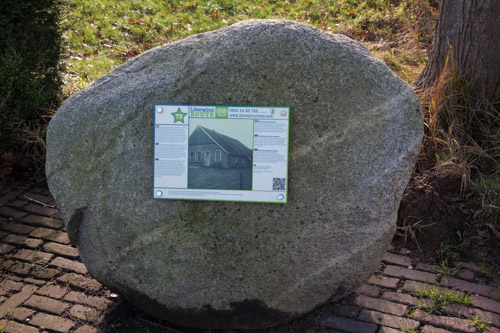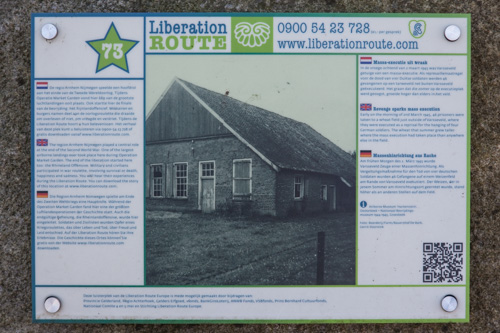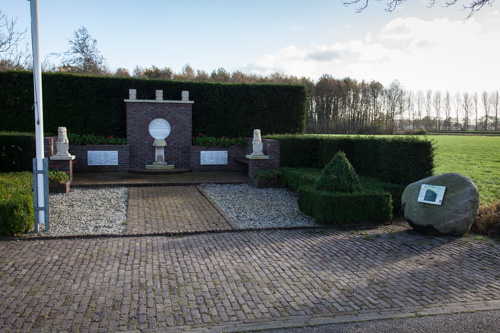Liberation Route Marker 073: Revenge sparks mass execution
Revenge sparks mass execution
Early on the morning of 2nd March 1945, 46 prisoners were taken to a wheat field just outside of Varsseveld, where they were executed as a reprisal for the hanging of four German soldiers. The wheat that summer grew taller where the mass execution had taken place than anywhere else in the field.
Resistance Group de Bark
A group of about thirty resistance fighters, people in hiding and Allied pilots sat together on Feb. 25, 1945, in farm de Bark southeast of Varsseveld. From afar, three German soldiers approached. The group kept as quiet as a mouse, hoping the soldiers would move on. However, that did not happen. The soldiers entered the farm and opened cupboards, possibly hoping for food. What they found indicated the presence of the resistance group.
Devil's dilemma
The resistance group had no choice but to capture the three Germans and the group's driver, who had been left outside by the car. A diabolical dilemma was emerging. Releasing them was not an option - alarms would certainly be raised - but neither was holding them prisoner. The resistance fighters therefore decided to kill the German soldiers by means of the noose. To stage an accident, the car with the corpses was placed against a tree along the road from Varsseveld to Aalten and blown up. The same day, the only partially burned car with the corpses was found by a German patrol. Traces made it clear that the occupants had been liquidated.
Retaliation
The German occupiers took gruesome revenge. Because the perpetrators could not be caught, it was decided to execute 46 people from Doetinchem prison. These “Todeskandidaten” had been imprisoned for relatively minor offenses, or sometimes only for the suspicion thereof. Early on March 2, the 46 prisoners were taken to Varsseveld, to a wheat field near where the car had been found. There they were executed with machine guns.
Audiospot - Revenge sparks mass execution
Liberation Route Europe is a certified Cultural Route of the Council of Europe. With hundreds of sites and stories in nine European countries, the route links the main regions along the advance of the Allied Forces in 1943-1945.
The entire route consists of themed routes that can be travelled by by hiking, walking, cycling and car. These routes pass numerous historical and interesting sites and tell stories from a multitude of perspectives that were important in the final phase of World War II.
Many routes feature listening spots, offering the opportunity to listen to a historical story at a location. In addition, many ‘Vectors of Memory’ have been placed, indicating that the passer-by is on one of the Liberation Routes.
The routes can be found on the Liberation Route Europe website or in the app through which many stories can also be listened to.
Do you have more information about this location? Inform us!
Source
- Text: TracesOfWar & Liberation Route Europe
- Photos: Arjan Vrieze
Nearby
Museum
- War Collection 40-45 Aalten - Aalten
- Dutch National Hideout Museum Aalten - Aalten
- Borderland Museum Dinxperlo - Dinxperlo
Point of interest
- Hiding Hut Zieuwent - Zieuwent
- Den Diek Lichtenvoorde - Lichtenvoorde
- Staff Quarter General Student Dinxperlo - Dinxperlo
Monument
- War Memorial Rademakersbroek - Varsseveld
- Memorial Ladies Jolink Varsseveld - Varsseveld
- Liberation Memorial Varsseveld - Varsseveld
Cemetery
- Dutch War Graves General Cemetery Varsseveld - Varsseveld
- Commonwealth War Graves General Cemetery Varsseveld - Varsseveld
- Dutch War Graves General Cemetery Aalten - Aalten
Remembrance Stone
- Stumbling Stones Spoorstraat 19 - Varsseveld
- Stumbling Stones Eikenlaan 14 - Varsseveld
- Stumbling Stone Vellegendijk 17 - Aalten






